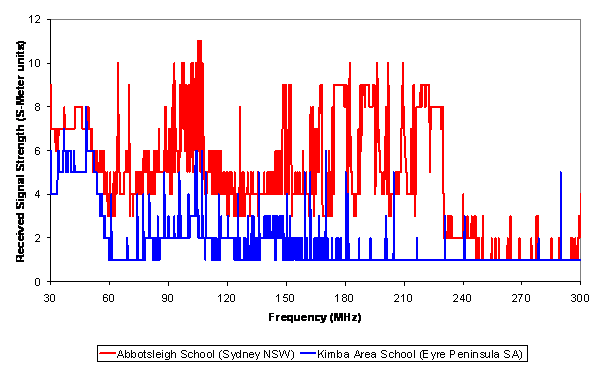SEARFE project report
The SEARFE Project (Students Exploring Australia's Radio Frequency Environment) aims to give senior high-school students practical experience in the value and use of the radio-frequency spectrum, an overview of the scientific objectives of the next generation radio telescopes and a practical understanding of why these telescopes have to operate in radio-quiet areas. The project is in a pilot phase at present, with students at schools in Sydney, Canberra, Narrabri, Kimba (South Australia) and Geraldton (Western Australia) participating in the project. The schools involved in the project are provided with a SEARFE kit, comprising a 0 - 2 GHz receiver, 25 - 1300 MHz discone antenna, laptop computer, receiver control and data logging software, and student and teacher instruction and resource material.
The students have been using the equipment to explore their local radio-frequency environment and posting and comparing their results with other schools via the SEARFE data archive website. Recently the students have been exploring the Very High Frequency (VHF) band (30 - 300 MHz) of the spectrum, which the Low Frequency Array (LOFAR) next-generation radio telescope will operate in. Results contrasting how the VHF band is used in urban Sydney and the remote town of Kimba on the Eyre Peninsula of South Australia are shown in Figure 1.

Figure 1: Comparison of SEARFE results collected in urban Sydney, NSW and country Kimba, SA, demonstrating how much more of the spectrum is used in Sydney and how much radio-quieter it is in Kimba. The vertical S-meter scale is logarithmic, with each increment of 1 corresponding to roughly a doubling in received signal strength.
The SEARFE project has received considerable media attention lately. Channel Ten's Totally Wild programme screened a story on the SEARFE Project on 12 August, which highlighted the work the Sydney Abbotsleigh School students are doing on the project and interviewed the SEARFE Project Co-ordinator: ATNF's Dr George "Nyima" Warr. On 4 August, the Geraldton Guardian ran a story on a presentation the local Nagle Catholic College students made on their work on the SEARFE Project to the delegates of the International SKA Conference 2003 held in Geraldton (Figure 2). The SEARFE Project was on display at the Australian Square Kilometre Array Consortium (ASKAC) stand at the Astro Expo at the International Astronomical Union General Assembly (GA) held in Sydney from 15 - 24 July. During this time Nyima was interviewed by the Sun Herald for an article on radio quiet zones, which appeared on 27 July. The Abbotsleigh School students also presented the project at the School's day held during the Expo and there was a poster presentation on the project at the Assembly and a demonstration of the project at the associated Astronomy Day for Teachers Workshop following the GA.

Figure 2: Geraldton Nagle Catholic College students Alice Wenderling, Hoanh Hoang, Adam Harvey and Kylie Judd (pictured) and Candice Woodhams and Maree Altham (out of frame) explaining their work on the SEARFE Project to International SKA Steering Committee chair, Jill Tarter (left), and other conference delegates at the International SKA Conference 2003 in Geraldton.
Leading up to the GA, the SEARFE Project was a major feature in the UNSW-led "Astronomy on the Go" programme that toured more than a dozen schools in regional NSW and several schools in Sydney. Since the Assembly, SEARFE has been on display at the UTS stand, "Science in the City", at the Australian Museum on 17 August and again with UTS in "Science in the Bush" in Tamworth over 25 - 28 August.
Given all this activity, it is wonderful to report that IBM Australia has just donated four new laptop computers to the SEARFE project to enable the project to reach more schools and students. We are investigating using one of these in a SEARFE kit hosted at the Parkes radio telescope Visitors Centre, where there are a high number of school visits and expert staff available to talk about the project and its relation to the next generation radio telescopes. We may well inspire some of these students to go on to design or use these next generation radio telescopes! If you are interested in finding out more about the SEARFE Project please visit the SEARFE website at www.searfe.atnf.csiro.au .
George "Nyima" Warr, SEARFE Project Coordinator
(George.Warr@csiro.au)
